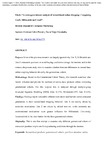A Cross-Generational Analysis of Second-Hand Online Shopping: Comparing GenX, Millennials and GenZ

View/
Use this link to cite
http://hdl.handle.net/2183/40060Collections
- Investigación (FEE) [923]
Metadata
Show full item recordTitle
A Cross-Generational Analysis of Second-Hand Online Shopping: Comparing GenX, Millennials and GenZDate
2025Citation
Calvo-Porral, C. and Viejo-Fernández, N. (2024), "A cross-generational analysis of second-hand online shopping: comparing GenX, millennials and GenZ", Journal of Consumer Marketing, Vol. ahead-of-print No. ahead-of-print. https://doi.org/10.1108/JCM-04-2024-6725
Is version of
https://doi.org/10.1108/JCM-04-2024-6725
Abstract
[Abstract] Purpose: The purpose of this study is to examine whether there are differences in second-hand online shopping behavior driven by the generational cohort. Design/methodology/approach: Based on the generational cohort theory, this research examines what factors influence and prevent the purchase of second-hand products online, comparing generational cohorts. For this purpose, data are analyzed through multiple-group structural equation modeling (SEM) (Gen X = 176; Millennials = 197; Gen Z = 233). Findings: Findings report noticeable different motivations and barriers across consumer generations in their second-hand shopping behavior: Gen X are mostly driven by economic motivations; Gen Z are driven by ethical motives, while economic and environmental motivations exert greater influence for Millennials. Conversely, functional risk is the main barrier for the three generational cohorts. Originality/value: To the best of the authors’ knowledge, this is one first attempt to examine why different generational cohorts of consumers purchase or prevent from purchasing used items through the internet.
Keywords
Second-hand products
Generational cohorts
Purchase intention
Online
Generational cohorts
Purchase intention
Online
Description
This version of the article has been accepted for publication, after peer review, but is not the Version of Record and does not reflect post-acceptance improvements, or any corrections. The Version of Record is available online at: https://doi.org/10.1108/JCM-04-2024-6725
Editor version
Rights
© 2024, Emerald Publishing Limited. This AAM is provided for your own personal use only. It may not be used for resale, reprinting, systematic distribution, emailing, or for any other commercial purpose without the permission of the publisher.
ISSN
0736-3761





